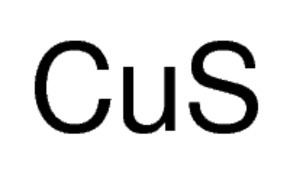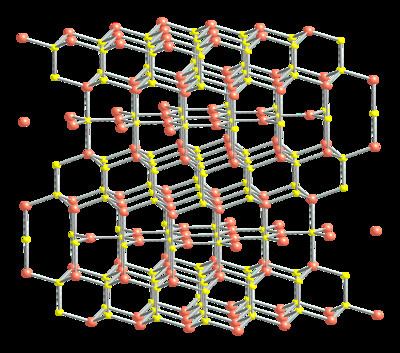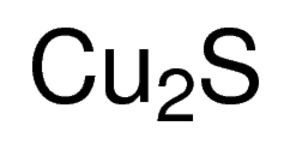Appearance black powder or lumps Formula CuS Melting point 500 °C | Molar mass 95.611 g/mol Density 4.76 g/cm³ | |
 | ||
Copper sulfide is a chemical compound of copper and sulfur. It occurs in nature as the dark indigo blue mineral covellite. It is a moderate conductor of electricity. A black colloidal precipitate of CuS is formed when hydrogen sulfide, H2S, is bubbled through solutions of Cu(II) salts. It is one of a number of binary compounds of copper and sulfur (see copper sulfide for an overview of this subject), and has attracted interest because of its potential uses in catalysis and photovoltaics.
Contents
Manufacturing
Copper sulfide can be prepared by passing hydrogen sulfide gas into a solution of copper salt.

Alternatively, it can be prepared by melting an excess of sulfur with copper(I) sulfide or by precipitation with hydrogen sulfide from a solution of anhydrous copper(II) chloride in anhydrous ethanol.

The reaction of copper with molten sulfur followed by boiling sodium hydroxide and the reaction of sodium sulfide with aqueous copper sulfate will also produce copper sulfide.
CuS structure and bonding

Copper sulfide crystallizes in the hexagonal crystal system, and this is the form of the mineral covellite. There is also an amorphous high pressure form which on the basis of the Raman spectrum has been described as having a distorted covellite structure. An amorphous room temperature semiconducting form produced by the reaction of a Cu(II) ethylenediamine complex with thiourea has been reported, which transforms to the crystalline covellite form at 30 °C.
The crystal structure of covellite has been reported several times, and whilst these studies are in general agreement on assigning the space group P63/mmc there are small discrepancies in bond lengths and angles between them. The structure was described as "extraordinary" by Wells and is quite different from copper(II) oxide, but similar to CuSe (klockmannite). The covellite unit cell contains 6 formula units (12 atoms)in which:

The formulation of copper sulfide as CuIIS (i.e. containing no sulfur-sulfur bond) is clearly incompatible with the crystal structure, and also at variance with the observed diamagnetism as a Cu(II) compound would have a d9 configuration and be expected to be paramagnetic.
Studies using XPS indicate that all of the copper atoms have an oxidation state of +1. This contradicts a formulation based on the crystal structure and obeying the octet rule that is found in many textbooks (e.g.) describing CuS as containing both CuI and CuII i.e. (Cu+)2Cu2+(S2)2−S2−. An alternative formulation as (Cu+)3(S2−)(S2)− was proposed and supported by calculations. The formulation should not be interpreted as containing radical anion, but rather that there is a delocalized valence "hole". Electron paramagnetic resonance studies on the precipitation of Cu(II) salts indicates that the reduction of Cu(II) to Cu(I) occurs in solution.
